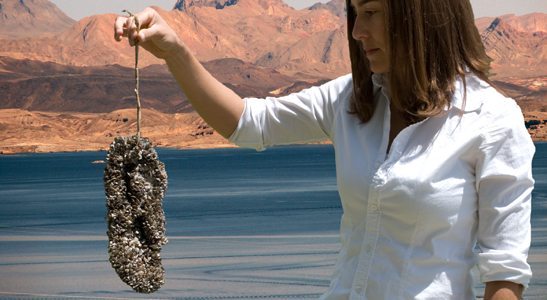A routine inspection of Salt River Project’s canal system last month has yielded evidence of quagga mussels at Arizona Falls on the Arizona Canal and on a canal structure in the Crosscut Canal. This is the first evidence of adult mussels in SRP’s canal system.
SRP crews on July 12 found a quagga mussel settlement during an inspection of monitoring points along the Arizona Canal. Both checkpoints contained a very small amount of adult mussels — four at Arizona Falls and less than 20 in the Crosscut Canal. Indications were that the mussels were recent arrivals at both facilities, which are located along canals on the north side of the Salt River.
Inspection points on canals and laterals located south of the Salt River remain free of quaggas. There is still no evidence of quagga mussels in the SRP reservoir system on the Salt and Verde rivers, which are also monitored regularly. Boaters are urged to continue to “clean, drain and dry” their boats to prevent introducing quagga mussels to the reservoir system.
Nina Mullins, senior director of Water Shareholder Operations, said SRP is coordinating with the Bureau of Reclamation and other federal and state agencies to evaluate methods of reducing the impact of the invasive species and will continue to communicate any updates or changes regarding the status of the quagga mussels to SRP’s water customers and municipal partners.
“Although the quagga mussel numbers are very few, we want to continue to ensure that our water transmission and delivery system stays in peak operating condition to serve all of our water customers,” she said. “We expected to find these mussels in our canal system eventually, so we are very fortunate that they were discovered early and that we’ll have a head start in deciding how we’ll minimize their presence.”
Each fall and winter, portions of SRP’s major canals north and south of the Salt River are dried up for about a month, each side separately, so construction and maintenance work can be done. Mullins said that the next scheduled dry-ups in November and January will also provide an opportunity for SRP crews to look for further evidence of mussels and to implement increased controls to protect facilities located along the canals.
Mullins said the checkpoints at both facilities on the Arizona and Crosscut canals where the quagga mussels were found are located in slower sections of the canal, but that the discovery in the Arizona and Crosscut canals may indicate adaptation to SRP canal system conditions.
Previously, adult quagga mussels were spotted three times – in 2008, 2009 and earlier this year — at the doorstep of SRP’s water-delivery system, the SRP-CAP Interconnect Facility, where SRP takes occasional deliveries of Central Arizona Project water.
Quagga mussels were inadvertently introduced into Lake Mead, and have spread along the Colorado River since first detected in 2007. They now can be found in Mohave, Havasu and Lake Pleasant reservoirs, and are assumed to be spreading in the Central Arizona Project system. SRP was taking deliveries of CAP water via SRP’s northside canal system in recent months.
Quagga mussels attach to hard surfaces such as concrete and pipes, and can multiply rapidly. Mussels can affect canals, aqueducts, water intakes, dams and power plants, resulting in significant maintenance costs. The mussel can also damage watercraft and impact lake ecosystems and fisheries.
Mullins said SRP will continue its collaboration with the U.S. Forest Service and the Bureau of Reclamation to support the “Don’t Move a Mussel” campaign to limit the spread of quagga mussels in Arizona’s waterways. More information about the outreach campaign is available on SRP’s website at www.srpnet.com/quagga or the Arizona Department of Fish and Game website.
SRP is the largest provider of water and electricity to the greater Phoenix metropolitan area, delivering about 1 million acre-feet to agricultural, urban and municipal water users and providing electric service to about 970,000 customers.




